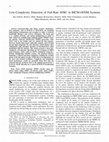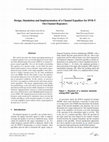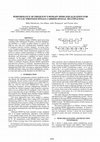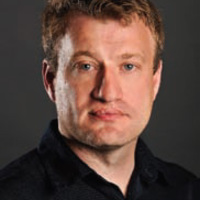Papers by Mikel Mendicute

IEEE Transactions on Communications, 2012
Last-generation and future wireless communication standards, such as DVB-T2 or DVB-NGH, are inclu... more Last-generation and future wireless communication standards, such as DVB-T2 or DVB-NGH, are including multi-antenna transmission and reception in order to increase bandwidth efficiency and receiver robustness. The main goal is to combine diversity and spatial multiplexing in order to fully exploit the multiple-input multiple-output (MIMO) channel capacity. Full-rate full-diversity (FRFD) space-time codes (STC) such as the Golden code are studied for that purpose. However, despite their larger achievable capacity, most of them present high complexity for soft detection, which hinders their combination with soft-input decoders in bit-interleaved coded modulation (BICM) schemes. This article presents a novel low-complexity soft detection algorithm for the reception of FRFD space-frequency block codes in BICM orthogonal frequency-division multiplexing (OFDM) systems. The proposed detector maintains a reduced and fixed complexity, avoiding the variable nature of the list sphere decoder (LSD) due to its dependence on the noise and channel conditions. Complexity and simulation-based performance results are provided which show that the proposed detector performs close to the optimal log-maximum a posteriori (MAP) detection in a variety of DVB-T2 broadcasting scenarios.
A fixed-throughput Wiener filter vector precoding (VP) approach specially suitable for hardware i... more A fixed-throughput Wiener filter vector precoding (VP) approach specially suitable for hardware implementation in field programable gate array (FPGA) devices is introduced in this paper. The lattice decoding algorithm, which is based on the sphere decoder (SD) lattice search, performs in its first stage a reordering of the matrix to be used for the tree search. Afterwards, the search tree is configured so as to yield an appropriate BER performance, and a fixed-complexity search is carried out. Simulation results show that the BER performance of the proposed algorithm is very close to the ML solution whereas its complexity is significantly smaller than that of the SD algorithm or the exhaustive search method.
We propose a new pilot structure for inter-carrier interference (ICI) estimation and compensation... more We propose a new pilot structure for inter-carrier interference (ICI) estimation and compensation in order to improve the performance of the forthcoming Digital Video Broadcasting-Next Generation Handheld (DVB-NGH) standard in mobile environments. Although classical pilot patterns and channel estimation techniques achieve good performance in fixed reception, their design can be improved for high-mobilty receivers, where the effects of ICI become more severe. For such scenarios, we propose to approximate the ICI and channel parameters using a basis expansion model (BEM). The proposed channel estimation model is assessed with new pilot designs and in combination with an ICI mitigation algorithm, showing the effectiveness of this technique by removing the error floor experienced with the ideal channel knowledge case with large Doppler frequencies.

This article describes the design and implementation of a channel equalizer for a terrestrial dig... more This article describes the design and implementation of a channel equalizer for a terrestrial digital television (digital video broadcasting-terrestrial, DVB-T) on-channel repeater, namely gap-filler. Two are the benefits of including this equalizer in a repeater setup: on one hand, the transmitted signal requires a lower dynamic range and its degradation becomes smaller at the output amplifiers, thus allowing for a higher transmit power for the same modulation error rate (MER). On the other hand, it eases the equalization and decoding processes at the final receiver by improving its operation conditions. In this context, we present a novel low-cost equalizer architecture for mid-range and domestic gap-fillers. The design, implementation and validation methodology is also described, from the initial Matlab and advanced design system (ADS) simulations to the final hardware implementation, based on a field programmable gate array (FPGA) device and a Blackfin digital signal processor (DSP). The obtained practical results assess the performance gains predicted by simulation, hence proving the validity and efficacy of the designed equalizer to reduce the cost of the amplifiers and to obtain a better signal quality at the final userpsilas receiver.
This paper proposes a novel framework for reducing the inter-carrier interference (ICI) caused by... more This paper proposes a novel framework for reducing the inter-carrier interference (ICI) caused by timevarying channels in mobile OFDM systems. The proposed ICI suppressing scheme is based on the application of the sumproduct (SP) algorithm to a factor graph (FG) representing the joint a posteriori probability (APP) of the transmitted symbols. Simulation results show that this new iterative soft-input soft-output (SISO) detection strategy achieves good performance when the ICI power is high, which can be due to high mobility or the use of large FFT sizes. We discuss its application to the reception of the new DVB-T2 broadcasting standard for a set of realistic mobile scenarios.

Focusing on densely deployed wireless sensor networks, this paper presents a novel method for joi... more Focusing on densely deployed wireless sensor networks, this paper presents a novel method for joint source-channel-network coding of distributed correlated sources through multiple access relay channels. In such networks, the role of intermediate sensors as relay nodes permits to achieve enhanced end-to-end error performance and increased spatial diversity in presence of channel fading. This paper addresses this scenario for a two source, single relay architecture by proposing a novel coding approach based on concatenated Zigzag codes, whose low complexity is specially suitable for energy-constrained autonomous systems. Joint decoding and estimation of the parameters defining the correlation between sensors is iteratively performed at the receiver side. Simulation results show that the proposed joint coding scheme attains significant energy gains with respect to traditional routing techniques, specially at high signal to noise ratios.

Multiple-input multiple-output (MIMO) signal processing combined with orthogonal frequency divisi... more Multiple-input multiple-output (MIMO) signal processing combined with orthogonal frequency division multiplexing (OFDM) is a widely accepted solution to achieve the high bit rates that new communication standards require in frequency-selective wireless channels. In recent years, a new frequency-domain equalized (FDE) cyclic-prefixed single-carrier (CPSC) block transmission system has been proven to achieve similar performance to OFDM for coded systems with the same overall complexity, avoiding its main drawbacks and becoming a candidate for future wireless standards. A FDE CPSC spatial multiplexing system is analyzed and compared to OFDM. The implementation of different frequency-domain MIMO equalization and detection schemes is evaluated. Simulation-based performance results prove the efficiency of FDE CPSC based spatial multiplexing systems and highlight that these transmission schemes can outperform OFDM in uncoded and high coding rate MIMO systems, as it has been shown in the literature for the SISO case.
This paper presents the design, simulation and performance of a low-cost echo canceler for its ap... more This paper presents the design, simulation and performance of a low-cost echo canceler for its application to on-channel repeaters in single frequency DVB-T networks. In these devices an echo canceler is required in order to avoid the coupling echoes produced between transmission and reception antennas. The designed echo canceler is based on an adaptive FIR filter where a correlation-based LMS algorithm (namely, CLMS) is used for updating the set of complex coefficients under a minimum squared error (MSE) criteria. The implemented prototype includes an analog devices floating-point DSP and a Virtex II Pro FPGA core. Computer simulation results and the registered in-lab measurements of the prototype verify that our approach shows surprisingly satisfactory echo attenuation capabilities at a minimal computational cost.
This contribution analyzes the integration of the sphere decoder (SD) in a complete field-program... more This contribution analyzes the integration of the sphere decoder (SD) in a complete field-programmable gate array (FPGA)-based real-time multiple input-multiple output (MIMO) platform. The algorithm achieves the performance of the maximum likelihood detector (MLD) with reduced complexity. However, its non-deterministic complexity, depending on the noise level and the channel conditions, hinders its integration process. This paper evaluates the performance and limitations of the SD in a real-time environment where signal impairments, such as symbol timing, imperfect channel estimation or quantization effects are considered.
As most state-of-the-art terrestrial transmissions standards, DVB-T2 uses orthogonal frequency di... more As most state-of-the-art terrestrial transmissions standards, DVB-T2 uses orthogonal frequency division multiplexing (OFDM) as modulation scheme. For performing channel estimation and equalization normally so-called frequency domain pilots are employed. As pilots are known information to the receiver, they do not carry any information and are thus overhead. Therefore, DVB-T2 also allows for a mode with nearly no frequency domain pilots, whereby the channel estimation is based on the data itself. This paper shows the high performance and throughput benefits of this pilot-free transmission and blind channel estimation technique while proposing an optimized algorithm.

Multiple-Input Multiple-Output (MIMO) signal processing combined with Orthogonal Frequency Divisi... more Multiple-Input Multiple-Output (MIMO) signal processing combined with Orthogonal Frequency Division Multiplexing (OFDM) is a widely accepted solution to achieve the high bit rates that new communication standards require in frequency-selective wireless channels. In recent years, a new Frequency-Domain Equalized (FDE) Cyclic-Prefixed Single-Carrier (CPSC) block transmission system has been proven to achieve similar performance to OFDM for coded systems with the same overall complexity, avoiding its main drawbacks and becoming a candidate for future wireless standards. In this paper, a FDE CPSC spatial multiplexing system is analyzed and compared to OFDM. The applicability of different frequency-domain MIMO equalization and detection schemes is evaluated. Simulation-based performance results prove the potential of these techniques and highlight that FDE CPSC can equal or outperform OFDM in uncoded and high coding rate spatial multiplexing systems, as it has been shown in the literature for the SISO case.
This paper analyzes the impact of inter-carrier interference (ICI) compensation on the physical l... more This paper analyzes the impact of inter-carrier interference (ICI) compensation on the physical layer of DVB-T2, the new digital terrestrial television standard. We compare the performance of a well-known low complexity soft demapper for different time-interleaving depths and code rates in several realistic mobile scenarios. This paper further presents an iterative receiver design that exchanges extrinsic information between the low-density parity-check (LDPC) decoder and the ICI canceller in order to improve performance. Provided simulation results show that the proposed ICI cancellation algorithms can be necessary in several DVB-T2 transmission modes when the length of the time interleaver is limited.

The development of a fingerprint verification system on a low-cost embedded platform still remain... more The development of a fingerprint verification system on a low-cost embedded platform still remains an open issue in nowadays biometrics. In order to shed light on this field, the contribution shown in this manuscript describes a lowcost fingerprint minutiae extraction and matching system based on a Spartan3 field-programmable gate array (FPGA) with an embedded Leon2 open core processor. The proposed system architecture incorporates a floating point unit (FPU) and a discrete Fourier transform (DFT) coprocessor which accelerates the minutiae extraction process. The verification algorithm is based on the NFIS (NIST Fingerprint Image Software) version 2 open source software developed by the National Institute of Standards and Technology (NIST). A software enhancement algorithm has also been included to further accelerate the minutiae extraction process. The results on execution time reduction and FPGA occupation for different system configurations show that the proposed architecture improves substantially the performance of the baseline system
This contribution analyzes the architecture design and FPGA implementation of high-throughput mul... more This contribution analyzes the architecture design and FPGA implementation of high-throughput multiuser vector precoders. The most complex task of such precoders, i.e. the search of the perturbing vector over an infinite lattice, has been carried out by means of two treesearch algorithms: a novel fully-pipelined complex-valued K-Best scheme and a fixed-sphere encoder (FSE). Both designs have been implemented in a Virtex-6 device, leading to precoding throughputs of up to 2.4 Gbps with 16-QAM modulation.
A fixed-throughput vector precoding (VP) approach specially suitable for hardware implementation ... more A fixed-throughput vector precoding (VP) approach specially suitable for hardware implementation in field programmable gate array (FPGA) devices is presented in this paper. The algorithm, which is based on the sphere encoder (SE), is divided into two main stages: at the preprocessing stage, the columns of the precoding matrix are ordered following any of the ordering approaches that have been proposed in this paper. Secondly, the search tree is configured so as to yield an appropriate bit error rate (BER) performance. Simulation results show that the BER performance of the proposed algorithm is very close to that of the SE, whereas its complexity is significantly smaller.
Besides the optimal but impractically complex dirty paper coding (DPC), linear precoding and vect... more Besides the optimal but impractically complex dirty paper coding (DPC), linear precoding and vector precoding (VP) have been proposed for the vector broadcast channel (BC). Linear precoding is simple, as only a linear transform is applied to the data signals, whereas VP necessitates a closest-point search in a lattice to find the perturbation signal which reduces the necessary transmit power. In this paper, we analyze the high signal-to-noise ratio (SNR) performance of VP assuming optimal decoding. As the perturbation process hinders the analytical assessment of the VP performance, lower and upper bounds on the expected data rate of VP systems are reviewed and proposed. Based on these bounds, VP is compared to linear precoding w.r.t. the weighted sum rate, the power resulting from a quality of service (QoS) formulation, and the performance when balancing the rates.
... intricate part of VP, namely the search for the perturbing signal in an infinite lattice. ...... more ... intricate part of VP, namely the search for the perturbing signal in an infinite lattice. ... in comparison to other fixed-complexity approaches, such as the K-Best precoder, under similar ... Linear precoders are usually designed to reverse the distortion that the channel inflicts on the ...

Recent and next-generation wireless broadcasting standards, such as DVB-T2 or DVB-NGH, are consid... more Recent and next-generation wireless broadcasting standards, such as DVB-T2 or DVB-NGH, are considering distributed multi-antenna transmission in order to increase bandwidth efficiency and signal quality. Full-rate full-diversity (FRFD) space-time codes (STC), such as the Golden code, have been reported to be excellent candidates, being their main drawback their detection complexity, which is enhanced when soft output is required when combined with a bitinterleaved coded modulation (BICM) scheme based on low-density parity check (LDPC) codes. We present a novel low-complexity soft detection algorithm for the reception of Golden codes in LDPCbased orthogonal frequency-division multiplexing (OFDM) systems. Complexity and simulation-based performance results are provided which show that the proposed detector performs close to the optimal detector in a variety of DVB-T2 broadcasting scenarios.










Uploads
Papers by Mikel Mendicute